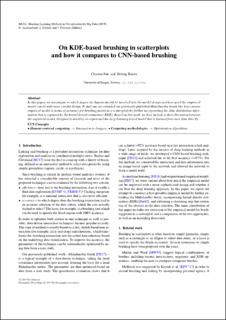| dc.contributor.author | Fan, Chaoran | |
| dc.contributor.author | Hauser, Helwig | |
| dc.date.accessioned | 2021-01-13T12:53:54Z | |
| dc.date.available | 2021-01-13T12:53:54Z | |
| dc.date.created | 2020-03-06T16:01:14Z | |
| dc.date.issued | 2019 | |
| dc.Published | In: Archambault, D., Nabney, I. and Peltonen, J. (eds.), Machine Learning Methods in Visualisation for Big Data | en_US |
| dc.identifier.isbn | 978-3-03868-089-5 | |
| dc.identifier.uri | https://hdl.handle.net/11250/2722780 | |
| dc.description.abstract | In this paper, we investigate to which degree the human should be involved into the model design and how good the empirical model can be with more careful design. To find out, we extended our previously published Mahalanobis brush (the best current empirical model in terms of accuracy for brushing points in a scatterplot) by further incorporating the data distribution information that is captured by the kernel density estimation (KDE). Based on this work, we then include a short discussion between the empirical model, designed in detail by an expert and the deep learning-based model that is learned from user data directly. | en_US |
| dc.language.iso | eng | en_US |
| dc.publisher | The Eurographics Association | en_US |
| dc.relation.ispartof | Machine Learning Methods in Visualisation for Big Data 2019 | |
| dc.title | On KDE-based brushing in scatterplots and how it compares to CNN-based brushing | en_US |
| dc.type | Chapter | en_US |
| dc.description.version | acceptedVersion | en_US |
| dc.rights.holder | Copyright 2019 the authors | en_US |
| cristin.ispublished | true | |
| cristin.fulltext | postprint | |
| cristin.qualitycode | 1 | |
| dc.identifier.doi | 10.2312/mlvis.20191157 | |
| dc.identifier.cristin | 1800233 | |
